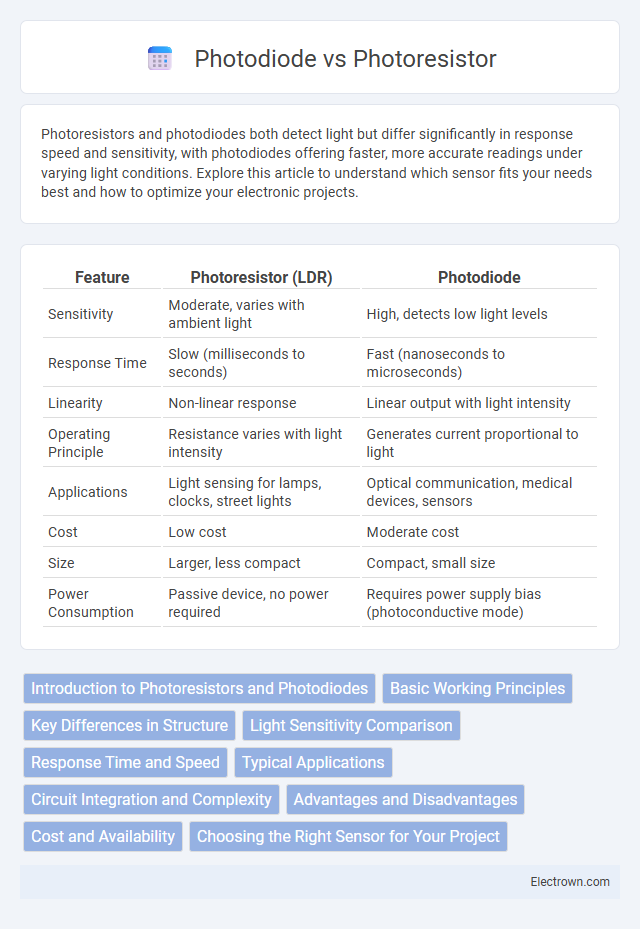Photoresistors and photodiodes both detect light but differ significantly in response speed and sensitivity, with photodiodes offering faster, more accurate readings under varying light conditions. Explore this article to understand which sensor fits your needs best and how to optimize your electronic projects.
Table of Comparison
| Feature | Photoresistor (LDR) | Photodiode |
|---|---|---|
| Sensitivity | Moderate, varies with ambient light | High, detects low light levels |
| Response Time | Slow (milliseconds to seconds) | Fast (nanoseconds to microseconds) |
| Linearity | Non-linear response | Linear output with light intensity |
| Operating Principle | Resistance varies with light intensity | Generates current proportional to light |
| Applications | Light sensing for lamps, clocks, street lights | Optical communication, medical devices, sensors |
| Cost | Low cost | Moderate cost |
| Size | Larger, less compact | Compact, small size |
| Power Consumption | Passive device, no power required | Requires power supply bias (photoconductive mode) |
Introduction to Photoresistors and Photodiodes
Photoresistors, also known as light-dependent resistors (LDRs), vary their resistance based on the intensity of ambient light, making them ideal for simple light sensing applications. Photodiodes are semiconductor devices that convert light into electrical current with faster response times and higher sensitivity than photoresistors. Both components serve critical roles in optical sensing but differ significantly in speed, accuracy, and application scope.
Basic Working Principles
A photoresistor, also known as a light-dependent resistor (LDR), changes its resistance based on the intensity of incident light, with resistance decreasing as light intensity increases. Photodiodes operate by converting light into an electrical current through the photoelectric effect, generating a current proportional to the light intensity when exposed to photons. Unlike photoresistors, photodiodes offer faster response times and higher sensitivity, making them suitable for precision light measurement applications.
Key Differences in Structure
Photoresistors consist of a semiconductor material that changes resistance based on light intensity, with a simple layered construction making them cost-effective but slower in response. Photodiodes are built with a p-n junction that generates current or voltage when exposed to light, allowing faster response times and higher sensitivity. The structural variance leads to distinct applications, with photoresistors suited for light detection in general environments and photodiodes favored in precision optical sensing and communication systems.
Light Sensitivity Comparison
Photoresistors and photodiodes differ significantly in light sensitivity, with photodiodes offering much faster response times and higher sensitivity to varying light intensities compared to photoresistors. Photoresistors, made from semiconductor materials like cadmium sulfide, change resistance based on ambient light but respond slower and are less precise for measuring quick light fluctuations. Your choice depends on whether you prioritize sensitivity and speed (photodiode) or simplicity and cost-effectiveness (photoresistor) for light detection applications.
Response Time and Speed
Photoresistors typically have slower response times ranging from milliseconds to seconds, making them less suitable for high-speed applications, whereas photodiodes offer rapid response times in the nanosecond to microsecond range, ideal for fast optical sensing. The intrinsic material properties and device architecture of photodiodes enable quicker charge carrier movement, resulting in superior speed compared to photoresistors. Choosing a photodiode over a photoresistor improves Your system's ability to detect rapid light changes with high precision and minimal delay.
Typical Applications
Photoresistors are commonly used in light-sensing applications such as street lighting, alarm systems, and night lights due to their high sensitivity to ambient light intensity. Photodiodes excel in high-speed and precision applications like optical communication, smoke detectors, and medical devices, providing fast response times and accurate light measurements. Your choice depends on whether you need slow, ambient light detection or fast, precise light sensing for electronic circuits.
Circuit Integration and Complexity
Photoresistors offer simple circuit integration due to their analog resistance changes in response to light, making them ideal for basic light-sensing applications with minimal components. Photodiodes require more complex circuitry, including amplifiers or converters, to interpret their fast and precise current output for high-speed or accurate light detection. Your choice between the two depends on the complexity and sensitivity needed in your circuit design.
Advantages and Disadvantages
Photoresistors offer the advantage of simplicity and low cost, making them suitable for detecting ambient light levels, but their slow response time and low accuracy limit their use in precision applications. Photodiodes provide fast response, high sensitivity, and linear output, ideal for precise light measurement and optical communication, though they require more complex circuitry and can be costlier. Your choice depends on the application's need for speed, sensitivity, and budget constraints.
Cost and Availability
Photoresistors are generally more cost-effective and widely available for basic light-sensing applications, making them suitable for budget-sensitive projects. Photodiodes tend to be more expensive due to their higher precision and faster response times but are increasingly accessible thanks to growing demand in advanced electronics. Your choice between these components should consider both budget constraints and the specific performance requirements of the intended application.
Choosing the Right Sensor for Your Project
Photoresistors offer cost-effective, simple light detection with slow response times, making them ideal for applications requiring basic ambient light measurement. Photodiodes provide faster response and higher sensitivity with precise light detection, suitable for tasks demanding accuracy and speed like optical communication or medical instruments. Choosing the right sensor depends on your project's need for speed, sensitivity, and environmental conditions.
Photoresistor vs Photodiode Infographic

 electrown.com
electrown.com